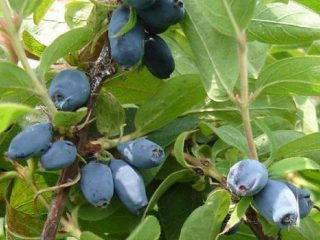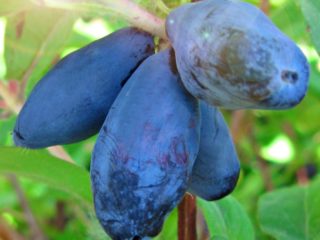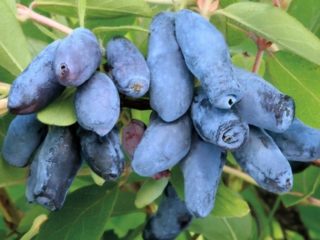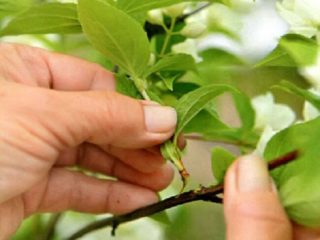Content
Honeysuckle flows sap very early; it is one of the shrubs that bears fruit in the first half of June. To avoid stressing the plant in the spring and damaging the buds, it is recommended to prune honeysuckle in the fall. A rejuvenating and shaping procedure will increase productivity; a strong and healthy bush will be less susceptible to diseases and pests.
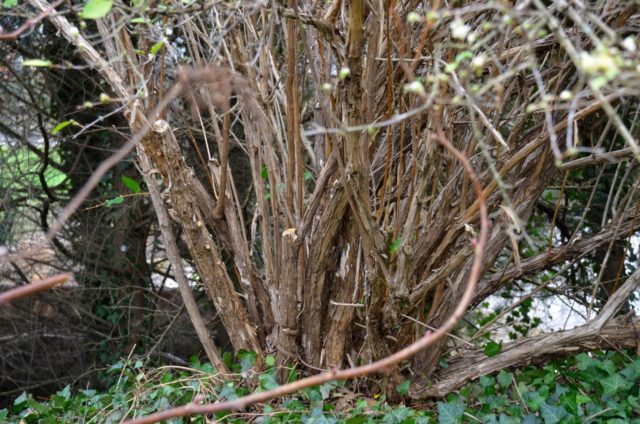
Autumn honeysuckle bush before formation
Is honeysuckle pruned in the fall?
Honeysuckle produces edible berries and has a decorative habit. The plant is multifunctional: in addition to useful fruits, it has a bright appearance from the beginning of flowering until the leaves fall; this feature has found application in ornamental gardening and landscape design. To prevent thickening of the bush, pruning is carried out every year.
Without timely action in the fall, at the beginning of the growing season, a compact green mass is formed, which blocks the access of ultraviolet radiation to the branches and buds, nutrition deteriorates, and productivity falls.
Perennial branches begin to die over time, and young ones appear in small numbers; the growing season of honeysuckle without pruning is not aimed at replacement. Every year the yield falls, and the bushes run wild. Flowering stops if decorative honeysuckle is not pruned in the fall; it loses its shape and aesthetic appearance.
Timing for pruning honeysuckle bushes in autumn
Perennial berry bushes of basic varieties begin to bear fruit in the 4th-5th year of the growing season. Until this time, the plant forms a root system and gains above-ground mass. Drastic pruning measures for up to four years are not relevant. The bush is shaped by shortening the top so that the crop produces more lateral shoots.
Pruning of honeysuckle in the first year of fruiting makes the harvest field. In subsequent growing seasons, the event is held in the fall. But there are also several nuances here that depend on the goal. Agrotechnical techniques in terms of functionality can be of the following types:
- Detailed (formative) trimming. It is carried out once every 4 years, old skeletal branches are removed, replacing them with new ones. In this case, it is advisable to prune honeysuckle after picking the berries, around the beginning of July; by autumn the plant will recover from stress and safely overwinter.
- Sanitary. There are no deadlines; it is carried out if the plant is sick and all therapeutic measures have not given a positive result. To prevent the infection from spreading further, the affected shoots are removed.
- Rejuvenating. This is the main type of agrotechnical technique aimed at the formation of young shoots; it is necessary every autumn.
Deadlines vary by region. It is not advisable to prune honeysuckle after harvesting, for example in August. In mild climates, shrubs are rejuvenated in November. In the temperate climate zone, they rely on weather conditions. The plant enters the dormant phase, completely sheds its leaves, and the completion of sap flow is determined by this sign. Rejuvenation of honeysuckle in the fall is carried out until night temperatures drop below zero.
Schemes for pruning honeysuckle in autumn
The basic rule in forming a bush to obtain berries is that you cannot prune the tops of last year’s shoots, as you can lose the main harvest.
All berry crops, including honeysuckle, love a lot of light. The sun's rays should penetrate unhindered into the middle of the bush. Below is a diagram of formative pruning of honeysuckle in the fall (by growing season).
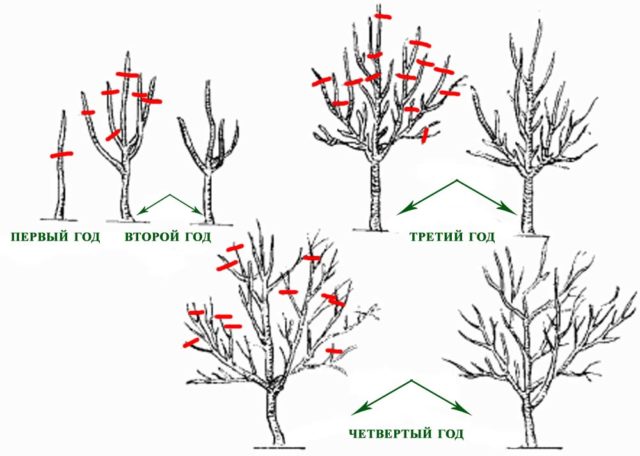
The shrub is formed according to the standard type
Trimming scheme:
- In the first year of growth in the fall, the top is shortened to 4 full buds.
- The next season, the young shrub forms several side shoots, and the top part is also removed from them.
- The bush continues to form in this way for up to four years.
- In the fifth year, 6-9 strong skeletal branches are left, they will become the basis, the lower stems are cut to vertical shoots, thus forming a trunk approximately 15 cm high. There is free space from the ground to the first shoots. This method will make caring for the root circle easier.
- Then cut out all the shoots and branches that grow into the middle of the bush and block access to the central part of the sun's rays. Also do not leave crooked ones with the wrong direction of growth.
The shoots of the crop are fragile; if the tops were broken during the work, they are cut off, and thin, weak stems are also removed. The spring option is not considered; sap flow begins when there is still snow. If agrotechnical measures are carried out at the beginning of the growing season, damage to fruit buds is inevitable.
Anti-aging pruning is also done in the fall, pruning bushes older than 7-9 years. The need for pruning is visible in the condition of the skeletal branches, which give little growth, their tops begin to dry out, and the bark peels off in ribbons.
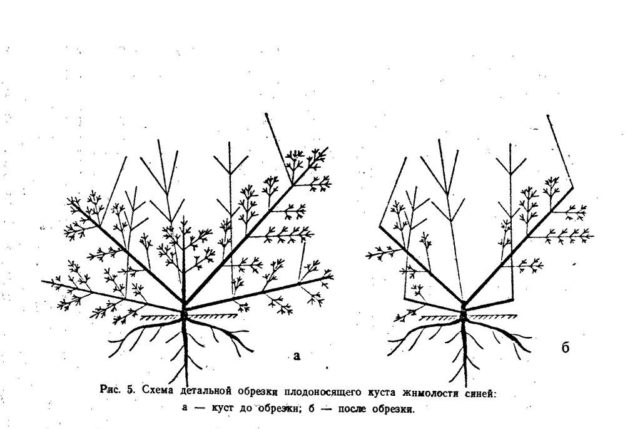
Do not touch annual branches, especially their tops.
Sequence of agrotechnical actions:
- Remove the maximum number of old branches, leaving only a few central ones.
- The tops of the lower ones are removed until the first annual strong shoots grow vertically.
- Weak annual stems are pruned, which do not produce full flowering and only thicken the bush.
If, after inspecting the bush, it is decided that the plant has become almost all old, do a drastic pruning. The bush is completely shortened regardless of the age of the stems. Leave approximately 40 cm above the soil.
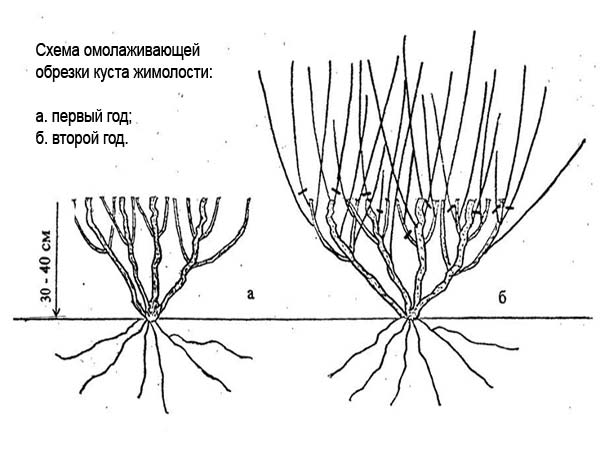
Scheme for correct pruning of an old plant
From spring, the growing season of honeysuckle will be aimed at replacing shoots. The next season the plant will give a bountiful harvest. After 3 years, you can do formative pruning, leaving strong shoots that will become skeletal branches. The bush is thinned out in the fall and weak stems are removed.
Sanitary pruning is carried out regardless of the season and age of the shoots; here we are not talking about a high yield, but about preserving the berry crop.
How to prune honeysuckle in the fall
To preserve the yield and decorative habit, agrotechnical measures are carried out at the end of the growing season. Several rules for pruning honeysuckle in the fall:
- The formation or rejuvenation of the bush begins only after leaf fall, then the plant is in the biological resting phase, it can more easily withstand mechanical stress.
- They use special tools for work, for example, garden shears with long handles; they are less dangerous for young stems.
- You can trim dry branches on annual shoots, but the top part should not be touched.
- The tops of perennial branches are removed before branching; in these areas the main accumulation of dormant fruit buds is observed.
During the period of berry formation, young shoots can bend under the weight of the harvest, especially if their length exceeds 50 cm. To avoid deformation of the shoots, it is recommended to fix them to a support. Near the bush, they drive a stake along the height of the plant, carefully collect the branches into a loose bunch, wrap them with rope and tie them to the trellis.
Advice from experienced gardeners on autumn pruning of honeysuckle
To ensure that the shrub does not suffer and is pleased with a good harvest in the spring, below are some tips for novice gardeners:
- cuts on branches are made at an angle;
- after work, damaged areas are treated with a disinfectant or garden varnish is used;
- if in the fall the night time is accompanied by frosts, you cannot form a bush at a later date;
- sanitary measures must be carried out only if it was not possible to save the plant from infection by chemical means;
- After agrotechnical practices, it is recommended to apply autumn fertilizing, and in temperate climates, insulate the root circle with straw or sawdust.
If the formation of a bush of food varieties begins from the fourth year of growth, then decorative cultivars are formed from the first growing season.
Conclusion
Pruning honeysuckle in the fall is a mandatory and annual procedure for the crop. Helps maintain the shape of the bush and a high fruiting rate. Removing old, weak and damaged shoots stimulates the berry crop to form a replacement. If agrotechnical practices are followed, the bush gets sick less often and produces large berries. For novice gardeners, below is a video on how to properly prune honeysuckle in the fall with maximum benefit for the plant.



